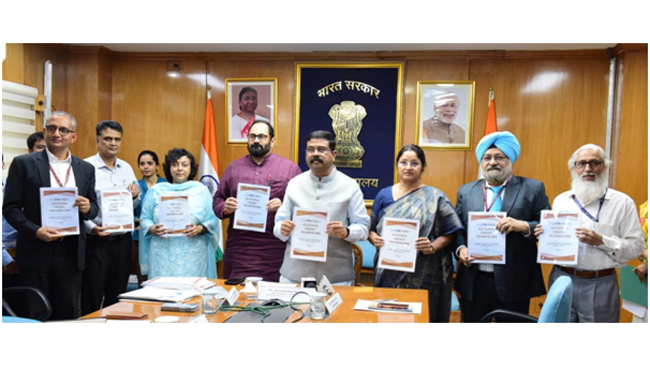
New Delhi, October 2022.
Union Minister of
Education and Minister of Skill Development & Entrepreneurship Shri
Dharmendra Pradhan launched the
draft of National Credit Framework (NCrF) for public consultation here today.
MoS, Education, Smt Annpurna Devi; MoS,
Skill Development & Entrepreneurship, Electronics & IT, Shri Rajeev Chandrasekhar Smt Anita Karwal;
Secretary, Higher Education Shri Sanjay Murthy; Secretary, Skill Development &
Entrepreneurship, Shri Atul
Kumar Tiwari; Chairman, NCVET; Shri Dr.Nirmaljeet Singh Kalsi and senior
officials of the Education and Skill Development Ministry attended the
programme.
Taking the vision of the new National
Education Policy (NEP) as envisioned under the dynamic leadership of Prime Minister, Shri Narendra Modi, the Government of India has developed
the National Credit Framework
(NCrF) to enable the integration of academic and vocational domains to ensure
flexibility and mobility between the two. NCrF would be a game changer by
opening numerous options for further progression of students and inter-mingling
of school and higher education with vocational education and experiential
learning, thus mainstreaming skilling and vocational education. NCrF will also
enable students who have dropped out of the mainstream education to re-enter
the education ecosystem.
Speaking on the occasion Shri Pradhan said that Jan-bhagidari is a key pillar of the Prime Minister
Narendra Modi’s governance and NEP 2020 also embodies the spirit of
Jan-bhagidari. He said that National Credit Framework is a next generation,
multidimensional instrument under NEP. We are dedicating NCrF for
‘Jan-paramarsh’ for making it more dynamic. Shri Pradhan further said that
National Credit Framework is an umbrella framework for skilling, re-skilling,
up-skilling, accreditation & evaluation encompassing our people in
educational & skilling institutions and workforce.
Shri Pradhan stressed that wehave to make India
a $5 trillion economy, accomplish the vision of a Vikasit Bharat in the next 25
years and empower 100% of our population and National Credit Framework will be
the most important instrument under NEP for realising these goals.India is
adopting technology at an unprecedented pace. We have to bring reforms to
incentivise knowledge, skills & experience.Credits for knowledge
acquisition, hands-on training, positive social outcomes will be a key step for
achieving 100% literacy in the next 2-3 years, he added.
The Minister appealed to all
institutions, schools, ITIs, AICTE-affiliated engineering colleges, centrally-funded
HEIs, state universities and regulatory authorities/bodies to host the public
consultation for National Credit Framework on their website for seeking
suggestions from citizens.
The
Committee constituted by the Government with members from UGC, AICTE, NCVET,
NIOS, CBSE, NCERT, Department of School Education and Literacy& Department
of Higher Education, Ministry of Education, DGT, and Ministry of Skill
Development under the guidance of Union Minister of Education and Minister of
Skill Development & Entrepreneurship, the inclusive umbrella framework aims to make the
options for Multiple Entry-Multiple Exit accessible and applicable across the
higher education, school education and vocational education, allowing students
to choose their own learning trajectories and programmes.
NCrF will seamlessly integrate the credits
earned through school education, higher education and vocational and skill
education by encompassing the National Higher Education Qualification Framework
(NHEQF), National Skills Qualification Framework (NSQF) and National School
Education Qualification Framework (NSEQF). It also supports educational
acceleration for students with gifted learning abilities and Recognition of
Prior Learning for the workforce that has acquired knowledge and skills
informally through the traditional family inheritance, work experience or other
methods.
The Government has now invited comments and
observations on the document which can be sent on: comments.ncrf@gmail.com.
Proposed benefits for various stakeholders are
as follows:
1. Students: NCrF
will ensure Flexibility in the duration of study/ courses through provisions of
multiple entries and exit/work options as well as pave the path for
creditisation of all learning hours, including academic, vocational and
experiential learning. It will also give the provision for lifelong learning –
any time anywhere learning: It will also help students by:
·
Establishing
multidisciplinary and holistic education with flexible curricula
·
Removing
the hard distinction between the education stream and making study choices
respectful, allowing for more than one award in the same period
·
Removing
the distinction between arts, science, social sciences, commerce, etc
·
Giving
student credits for every academic/ skill/ experience
·
Enhancing
the scope of core learning to include foundational and cognitive both
2. Institutions:NCrF will bring about a unification of higher education
institutions to promote multidisciplinary education, creating a diverse and
rich students knowledge base. It will also help in:
·
Promoting
stronger collaboration between institutions
·
Making
credit mechanism simpler and uniform
·
Increasing
focus on research and innovation
·
Promoting
digital learning, blended learning, and open distance learning
·
Leveraging
the institutional infrastructure
3. Government:NCrF is expected to assist the government to
increase the enrolment of students, helping to fulfil the national vision of
complementing the demographic dividend and transforming India into the Skill
Capital of the World. It will also:
·
Making
vocational education and training/ skilling aspirational
·
Highly
educated and trained workforce for Aatmnirbhar Bharat
4. Industry:NCrF will allow
students to attain NSQF-approved foundational skills developed by industry and
be more employable. The provision of micro-credentials will allow integration
of quick educational upgradation/ up-skilling It will also help in:
·
Re-Skilling
and up-skilling of existing employees/ engineers
·
Making
students more employable by enabling a more holistic design of the study
·
Creating
a multi/ cross-sectoral skilled pool of employable youth